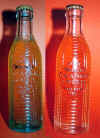 |
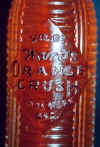 |
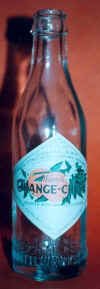 |
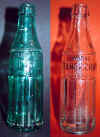 |
|
Fig 1 |
|||
by
: Michael Rosman
In my first expose on Orange Crush bottles, I dealt with the 'Krinkly',
amber colored ones - probably because those are the most unique and recognizable
to drinkers of soda pop - of a similar vintage to myself.
However, these amber ribbed bottles were preceded in the 1920's by a clear (transparent) version. The clear version began in the early 1920's and slowly disappeared with the introduction of the amber colored 'krinkly's in the 1940's. Their production however, did continue into the 1960's.
The first of these clear bottles carried the name of the Orange Crush founder, Ward [Fig.1], and then following the sale of the Orange Crush Bottling Company, Ward's name was removed from the diamond on the front of these bottles.
There ensued, two periods - the first, July 20, 1920, followed by a second period, August 22, 1922, when these clear krinkly's were patented and manufactured. During these two patent dates periods, all the clear krinkly's had an embossed diamond front and back.
The July 20, 1920 date, with a patent date embossed, appears on the 6, 7,
8, 24, 26 and 28 oz. bottles. The "Pat'd" is at the top of the
diamond.
The August 22, 1922 date appears only on the 6 oz. bottles. It also appears on the rare 30 oz. Canadian bottle.
There was a short period, when some of the clear "krinkly's" were manufactured with the diamond embossing
- on the front only.
1. with "PATENTED" at the top of the diamond, no date
2. with "TMR" at the top of the diamond, dated August 22, 1921
3. with "PAT'D" at the top of the diamond, dated July 20, 1920
- on the front and the back
4. with "REG" at the top of the diamond, dated August 22, 1921
5. with "PAT'D" front and back, dated July 20, 1920
To confuse an already confusing description, there was a period, short lived, before July 20, 1920, when some clear krinkly's were manufactured with the diamond on the front only.
Similarly, there was a second short period, with a patent date of August
21, 1921, when the clear krinkly was manufactured with an embossed diamond on
the front only.
With this very confusing, but I hope understandable introduction, I will now try and describe the differences in the clear 'krinkly' bottles in order to further delineate their similarities and differences, and their availability or rareness.
Clear ‘krinkly’ bottles generally, follow a manufacturing pattern which seems to be a bit less complicated than the amber version, but still has some unusual differentiating patterns. Like the amber bottles, there is embossed diamond on both the front and the back of most bottles. The exceptions to this have been elucidated in the introduction.
There is, in the clear bottle, less variation in bottle shape, height and width than with the ambers. As well, there is less variation in that which is embossed, front and back - and that which appears is more often limited to a particular content size.
There are however, distinguishing features to these clear bottles which
help to classify, categorize and separate these for the ardent collector.
I will try to indicate some of these differences - perhaps missing a few,
perhaps erring, but here goes again.
The bottle SHAPE itself
- unlike
the amber bottles, the clear 6, 7 and 8 oz. were of uniform diameter, 2 1/8"
(5.5cm)
1) 6oz. - (7 3/4" / 20cm.) print only both sides
2) 6oz. -
(8 1/4" /
21cm.) print one side, Crushy
facing left* other side
*
(It should be noted that this is the only bottle manufactured by OC in
which Mr. Crushy faces LEFT. In
all other styles with Mr. Crushy, both amber
and clear, he faces right.)
3) 6oz - (8 3/4" / 22 cm.) print one side, Crushy facing right
4) 7oz. -
(8 3/4" /
22 cm.) print one side, two patterns on other side
i)
Crushy facing right
ii)
O C beverages
5) 8oz. - (8 3/4"
/ 22cm.) similar print, both sides
- rare
6) 24oz
- (11 1/2" / 29 cm.) narrower (3"), than 26 or 28oz., with and
without ounces embossed
7) 26oz -
(11" / 28cm.) more squat (31/2"), same print both sides
8) 28oz -
(11 1/2' / 29 cm.) print one side,(31/4"), OC beverages
other
9) 30oz - (11 3/4" / 30
cm.) frosted, print one side Aug.22/22, Crushy other side, Canadian
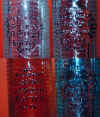 |
| Fig 2 |
During the early production of 6 oz. bottles with an embossed diamond on one side only dated August 22, 1922, there is a rare bottle which is tinted very lightly in green. Similarly, there are a few rare bottles in circulation, also 6 oz., with print on one side, Crushy facing left on the other, which were also tinted lightly in green. These two are very rare.
The embossed, FRONT
diamond - in the clear, 'krinkly' bottles, the print within the diamond on the front
varied greatly, dependant initially upon the year and
the contained number of ounces.
1) the 6 ounce - this is the classic, first edition, 7 1/2" clear bottle. It should also be noted that these bottles were truly clear glass. [Fig. 2]
a) 'PATENTED' written in
full, no date - no embossing on back. This bottle is rare, and was produced
before July 20, 1920
b) 'PAT'D', July 20, 1920 - embossed back
c) 'TMR' Aug.22, 1921 - no embossing on back
d) 'PAT'D', Aug. 22, 1921 - no embossing on back
e) ‘REG’, Aug. 22, 1922 - embossed back
 |
| Fig 3 |
2) the 6
ounce - here, bottle size variation
commenced, and Mr. Crushy was introduced into the embossing for the first time.
Also, in these bottles, the stippled, 'orange peel' texture was introduced,
making the clear glass more opaque. All have embossed back, 'PAT'D', July 20,
1920. [Fig
3]
a) the
8 1/4", Crushy
facing left, arm over head - rare
b) the 8 3/4", Crushy facing right, arm over head - common
3) the 7 ounce - in this
larger (8 3/4") bottle, the stippled pattern of the earlier 6 ounce was
maintained. A new front design (see below) was also introduced. As well, all had
a similar embossed back, 'PAT'D', July 20, 1920. There are two variations [Fig.
4], to the front -
a) Crushy facing right, arm
over head
b) embossed 'O C Beverages' - stippled neck, clear body
4) the 8 ounce - this bottle is rare! It combines the clearness of the 6 ounce, the size, both height and width of the 7 ounce, is embossed 'PAT'D', July 20, 1920 both front and back, and is also embossed 8 fl. ozs., on both diamonds. [Fig 5]
5) the
24 ounce - this bottle is common, along with the 28 oz. is the tallest OC
bottle and has embossed diamonds,
front and back with two variations - [Fig 6]
a) PAT’D July 20, 1920 without content
b) PAT’D July 20, 1920, with 24 oz. embossed
6) the 26 ounce - this bottle is much less common than either the 24 or 28 oz. It is shorter and squatter. Only one style of embossing existed - PAT’D July 20, 1920, with 26 oz. embossed, front and back.
7) the
28 ounce - this bottle is similar to the 7 oz. (Fig 4 above) with
'O C Beverages' embossed on one side and PAT'D
July 20, 1920 on the other face. It
should be noted that this style (in the 7oz. and 28 oz.) are the pattern taken
by the green or emerald 'krinkly' bottles
[Fig 7]
8) the 30 ounce - this bottle (Fig. 8), is uncommon. It is frosted or stippled throughout. On one side is Mr. Crushy, hand over his head, squeezing an orange, facing right, with the content embossed. On the opposite face is ‘REG’D Aug. 22, 1922
The TRADE MARK
- the greatest variety of patent information appeared on
the clear, 6 ounce bottles as outlined (see Fig.2) in the description above,
under the 'FRONT' diamond patterns.
This variation changed to a more permanent and uniform look
with the 7 oz. bottles - all the embossed diamonds started with
‘PAT’D’ at the top. The
only exception is the 30 oz. bottle which begins with 'REG'D.'
The 'Mr. Crushy’ figure - Mr. Crushy made his initial appearance on the 6 oz. bottles, with the introduction of the stippled, orange peel texture. As with the later amber bottles, Mr. Crushy always faced right. On the clear bottles, with his hand over his head, squeezing an orange.
Only on the earliest, stippled 6 oz. bottles, did Mr. Crushy face LEFT - and entity which makes this bottle quite rare. Most, if not all of these bottles came out of the Northeast, particularly Maine and New Hampshire.
To summarize - Mr. Crushy makes his initial appearance on the later, stippled 6 oz. and half the styles of the 7 ozs. Also on the 30 oz. This is in marked contrast to the amber bottles which all carry some variation of Mr. Crushy on their ACL - except the Canadian version.
The embossed BACK DIAMOND -
with the clear,' krinkly' bottles it may, in most cases be difficult to
distinguish the front from the back. In
most bottles, both are identical.
There are exceptions, where the embossed diamonds differ on both faces of
the bottle -
1. early 6 oz. with
'PATENTED' -
no back diamond
2. the 6 oz. and 7 oz. with Mr. Crushy
3. the 7 oz. with O C
4. the 28 oz. with O C
5. the 30 oz. with Mr.
Crushy
The bottle BASE - with the clear bottles, tremendous variation exists,
without an apparent pattern. There can be nothing or only the symbol of the
manufacturer, or the city and state of production. I have not been able in my
study of Orange Crush bottles, discern a pattern to the embossing of the bases
which follows any routine.
And so, once again, I have tried to simplify, for my fellow collectors,
the era of the CLEAR, ‘KRINKLY’ Orange Crush bottles - from 1910 to the
mid-1960's. These bottles are, with a few exceptions, still quite common, but I
hope that have helped to make it easier to distinguish their features, and
pointed out a few of the facets which makes some of these beautiful bottles
uncommon or even rare, and consequently of more value to collectors.
Perhaps these clear bottles are less memorable in our minds than the amber ones, but in terms of history, as well as beauty, they certainly have stood the test of time. I hope that along with my first article on the 'Krinkly' Amber bottles, that my fellow collectors will have a better understanding of this era of glass bottles associated with the Orange Crush Bottling Company.
Michael
Rosman is a collector of Orange flavored soft drink bottles and signs.
He can be contacted at - mrosman@sympatico.ca
|